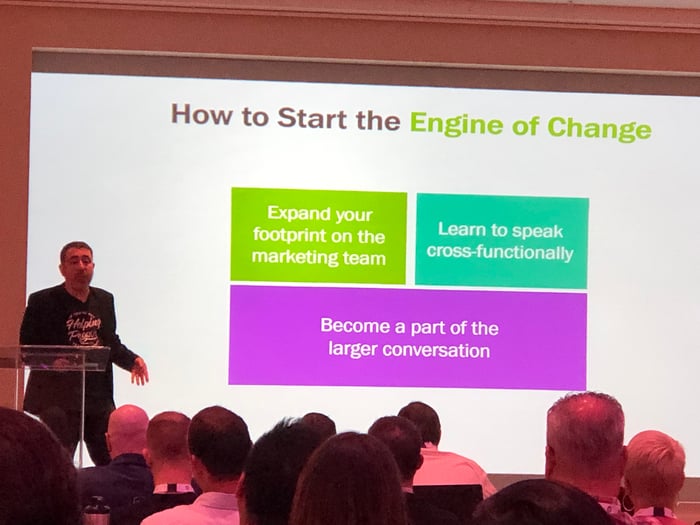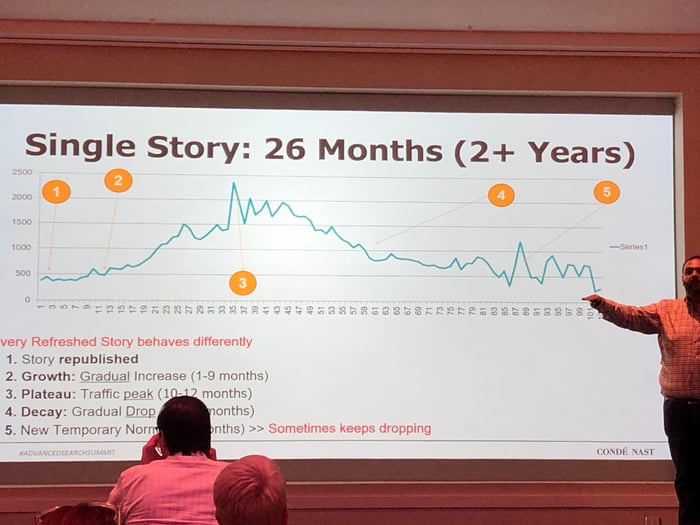
The term “SEO” was coined in 1997, and since then, digital marketers everywhere have been obsessed with understanding the inner-workings of search engines.
Spikes in traffic, higher website rankings, and crawl efficiency are just a few of the many events that can be attributed to SEO. This is why SEO has become such a hot commodity in recent years.
Understanding on-page, off-site, and technical SEO has been a priority here at G2, which is why we attended this year’s Advanced Search Summit in Washington D.C. to get the pulse on SEO and provide some insights of our own.
Click on an insight below to read more:
For some companies, this may be obvious, but you’d be surprised by how many companies implement website changes without informing their SEO teams. Stephan Bajaio, Chief Evangelist and Co-Founder of Conductor, stated in his keynote session that it’s time for SEOs to ensure their place at the decision-making table.
“How is this change going to affect our site when it’s implemented? What sort of value does it provide for our audience? What are our plans to test this change?”
Some examples Bajaio brought up resonated with the SEOs in the room. For example:

Takeaway: Involve your SEOs in website changes! Pick their brains, ask questions, and have them educate you on best practices. It will save time, money, and effort cleaning up the changes later on.
Search engine algorithms are constantly at work, discerning valuable and relevant content from impractical and outdated content. As a matter of fact, Google reportedly made 3,200 changes to search in the past year alone. John Shehata, Vice President of Audience Development Strategy at Conde Nast, says it’s important to notice when these changes begin to affect your content.
Shehata’s focus during his session was particularly on evergreen content, also known as high-traffic content that stays relevant for long periods of time.
The first step in the process is to identify top-performing content that is beginning to decay. You can do so through Google Analytics or any analytics tool your company uses. Select this content based on metrics like traffic, click-through rate (CTR), and backlinks. These will be your main pages.

Once these main pages are identified, start conducting a SERP analysis report. See what types of sites are ranking for a particular topic. Are they e-commerce, editorials, educational? Is there a featured snippet or news carousel? Take note of these, and begin targeting the snippets with more valuable content.
While you’re at it, conduct a content analysis for competing sites. What are the common characteristics? Are they using images or videos? What are the CTAs? How many items per ordered list? How long is the content? If you have the resources, there are also tools that use term frequency-inverse document frequency (TFIDF) mining to see which words are used often and their importance to the document.
After all of the analyses have been conducted and you’ve taken your notes, it’s time to refresh your main pages. Merge and consolidate relevant content from old or low-performing articles into the main pages, or 301 redirect them so you don’t lose old rankings and backlinks. Do additional keyword research to ensure you’re hitting the right terms. Add newer research or data if necessary.

Takeaway: Conde Nast’s refresh strategy saw a 900 percent increase in traffic, with 85 percent of refreshed content ranking higher. Their analysis of 500 decaying articles found that evergreen decay set in at about the 26-month mark. So, be on the lookout for old content that’s on the downward, and take your time when applying a meaningful refresh strategy.
Whether you just bought a new domain or are inheriting another company’s domain, you’ll need to successfully migrate over all that great content. Unfortunately, site migrations are notorious for causing headaches, along with losses in traffic and revenue. Fortunately, there are ways to mitigate these losses and successfully migrate websites.
Shawn Huber, Sr. SEO Specialist at T-Mobile, discussed at the Summit how he and his team were able to deal with inheriting Virgin Airlines’ website during his tenure with Alaskan Airlines.
“It starts with employing the RACI method,” he said, which helps hold people accountable and keeps the wheel of productivity moving. RACI refers to Responsible, Accountable, Consulted, and Informed. In the case of Alaskan Airlines, this was:
After the structure is laid out, it’s time to begin planning and scoping for the migration. This starts with a complete site audit to see what’s worth migrating over and what can be scrapped. Technical SEO specifications like sitemaps, pagination, internal linking, metadata, canonical tags, and many more should be examined during this process.
You’ll then need to do some pre-launch testing to review all the technical SEO elements, but be sure that search engines cannot access this testing site. Also, conduct a mobile-first index (MFI) review to see if there are any inconsistencies between mobile and desktop versions of the site. This is because Google has formally announced it’s crawling and indexing with the smartphone agent moving forward.
Map URLs 1:1 from old content to new content, and be sure to maintain and redirect backlinks so you don’t lose them in the migration process. While you’re at it, add and clean up any tracking parameters for better analytics tracking on the new site.
Takeaway: Yes, this is a simplistic rundown of site migration, but understanding the deep complexities of migrations and keeping everyone involved and educated will set you up for success. The RACI method is a great way to keep everyone in the know. And as always, consult with your SEO team on every move.
Being a content marketer isn’t just about writing great content and growing traffic, it’s also about being analytics-driven and generating high-quality backlinks. Russ Jones, Principal Search Scientist at Moz, discussed some unique ways to conduct backlink outreach.
While we can't touch on every backlink strategy, there are a few that can be implemented right away with good results.
Takeaway: Think of the email recipient and ask yourself, “what justifies me being in their inbox, and why would they want to go in and edit their website for one of my links.” The sooner you’re able to devise ways to help them, the more likely they’ll help you by providing high-quality backlinks.
It may not always seem like it, but Google has limited resources like any other company. With billions of websites live right now, Google can allocate only so many resources to each website – some more than others. These resources are referred to as “crawl,” which allows Googlebot to analyze your content and index it so it can rank on the search engine.
If your company:
All of these factors and more may affect how efficiently Googlebot crawls your website, thus, eating up your crawl budget.
Takeaway: Jori Ford, Director of Content and SEO at G2, discussed at the Summit ways to quantify your crawl budget. Having an idea where Google allocates its resources on your website could help you identify crawl patterns. So, if you weren’t aware of crawl budget before, now you understand how important it is to SEO.
Being surrounded by some of the brightest minds in SEO proved to me just how important the industry is in a world informed by search engines. If your company is serious about competing in the digital age, be adamant about consulting with your SEOs and magnifying their voices.
Want to see how G2 built its SEO strategy to reach more than 1 million monthly organic visits? Want to see how we did it in less than a year?
Read about our strategy for dominating the SERPs.
Devin is a former senior content specialist at G2. Prior to G2, he helped scale early-stage startups out of Chicago's booming tech scene. Outside of work, he enjoys watching his beloved Cubs, playing baseball, and gaming. (he/him/his)
Ask any programmer and they’ll tell you what they think about JavaScript.
 by Serge Bezborodov
by Serge Bezborodov
There are two ways that site owners have traditionally quantified the ROI of SEO traffic.
 by Manick Bhan
by Manick Bhan
Ask any programmer and they’ll tell you what they think about JavaScript.
 by Serge Bezborodov
by Serge Bezborodov
There are two ways that site owners have traditionally quantified the ROI of SEO traffic.
 by Manick Bhan
by Manick Bhan



